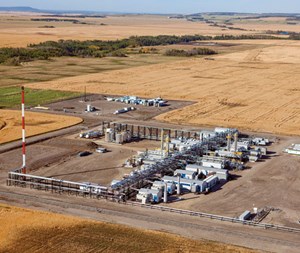Analytics can optimize oil and gas equipment performance, predict failures
Today, the oil and gas industry, like many others, is embracing a data-driven mindset—what’s driving the shift?
The downturn in oil and gas prices put pressure on producers to cut costs and maximize use of their existing, aging assets. But with operations more complex than ever, optimizing equipment can be an impossible task, when you are unable to answer critical questions about health and performance, such as: “Are we prepared to react to ongoing market changes? Why did a piece of equipment fail? How long until it fails again?”

It’s difficult to improve equipment availability and get ahead of failures, when you don’t have real-time insights into performance, or when the data you do collect are confined to silos. Without a doubt, the ability to collect raw data and turn them into useful information for workers is essential to staying competitive.
By 2020, Research and Markets predicts that $45 billion will be spent by our industry on IT and IoT technology.
Hoping to capitalize on the promise of the digital oilfield, oil and gas producers are seeking to implement new IoT technologies and connect their equipment, devices and systems, and integrate their data, Fig. 1. Most critically though, producers are looking for ways to transform all these data into operational intelligence.
Implementing analytics doesn’t have to be a mystery or an overwhelming task. A connected oil field that operationalizes data helps enable this transformation. In a connected environment, stakeholders have real-time insights to better understand equipment performance, and use those insights to predict future issues, allowing them to be addressed before they result in unexpected downtime.
WHERE TO START
Analytics involve monitoring large amounts of data from multiple sources, collecting and contextualizing those data into information, and then presenting that information to your workers in the form of useful, actionable insights.
This requires seamless connectivity across your oil field. The most basic job of analytics is to provide context to data. This could include well behavior and performance trends from artificial lift systems, or it can also include real-time performance from surface processing skids, remote wellhead monitoring systems, or insights into downhole and reservoir conditions. Furthermore, analytics can help users investigate anomalies and troubleshoot issues.
Oil and gas companies that want to create a roadmap for deploying analytics should first understand the three analytics categories, as well as their complexities and benefits:
Descriptive and diagnostic analytics are the starting point for producers. At the most basic level, those data inform workers about how things are performing and the conditions in which they’re operating. If a failure occurs, these analytics can help technicians quickly diagnose the problem, and help make sure they send the right person to the right place, with the right tools, to resolve the problem.
Predictive analytics are the target goal for many producers today. These analytics look for known conditions and relationships within the data that indicate a device or piece of equipment is approaching failure. Producers can use this to identify and prevent equipment failures before they happen, or prepare operations and maintenance for an impending equipment failure, providing a tremendous opportunity to reduce costly downtime.
Note: Predictive analytics won’t always be absolute. Sometimes they are configured around the probability of various failures. For example, a production team could set a threshold for a failure probability of 80%. If the software detects a failure probability at this threshold, it will trigger an alarm condition, and can notify users that a failure is impending and requires service.
Prescriptive analytics are the most complex analytical techniques for equipment maintenance and the ultimate goal for most oil and gas producers. Prescriptive analytics build upon predictive analytics to not only anticipate equipment failure, but also recommend corrective action, based on historical failure data and trends. Workers can use the recommended actions to correct issues and optimize performance of assets in real-time. When paired with techniques like augmented reality, operators or maintenance personnel can be guided through a set of digital instructions to repair a failed piece of equipment, or change operational parameters to improve process performance.
At the highest analytics level, users can view their entire operations on a single dashboard. This provides real-time, dynamic KPIs versus targets, and a prioritized list of required actions to meet business goals. In addition, current performance can be compared to past performance. Operators can drill deep into each site, viewing well-pad performance, and drilling even further into a well or pump’s performance.
Rod-pump control analytics, for example, can use downhole card information to provide insights into the downhole conditions, and identify whether equipment is running optimally and if intervention is required. Plunger-lift analytics are retrieved from the field and displayed as a timeline of well-performance indication, influencing key operator decisions, such as if pressure should be increased. Gas-lift analytics can help operators to know whether they’re over-injecting gas and identify the proper ratio of oil and gas injection.
ANALYTICS DEPLOYMENT
Consider the analytics approach when determining the solution best suited for your needs. In many cases, upgrades to existing infrastructure will be needed, before the operator can fully utilize data in a specific analytics strategy.
- Open architecture. Many producers use a mix of equipment, devices, sensors and software from different vendors. But some solutions are not vendor-agnostic, creating integration challenges that can impede a producer’s ability to access the valuable data needed to meet their goals.
° An open-architecture analytics approach will support the producer’s current technology investments. True connected oilfield solutions allow producers to combine analytical technologies with software, services and domain expertise from various oilfield service companies. This enables a digital solution that helps optimize production through real-time insights, to reduce operational risks and costs.
- Scalable solutions process data as close as possible to where the data originate, eliminating time delays, data reliability issues and the need for high-bandwidth communication networks.
° For example, device-level analytics can provide health and diagnostic information for critical devices, and even send alerts to stakeholders’ mobile devices, if a device needs attention. System-level analytics can create smarter equipment that asks for help before a failure occurs, or improve collaboration between internal and external stakeholders. And business-level analytics can be used to analyze production and operational performance.
- Accurate. One aspect of data often overlooked, but critical to achieve the accuracy and usefulness of analytics, is data integrity. The information solution should be able to validate data coming from the field, as well as minimize data gaps that could impact the results of analytical software and, hence, the decisions made by operators.
- Intuitive. Producers should consider how operators interact with the results of the analytics and other systems, as they take actions to improve the performance of operations. Intuitive, easy-to-use dashboards can help workers not only identify and understand critical production information, but also respond to it as quickly as possible.
- Advanced. Newer and more powerful ways of operator interaction with the equipment and the process are available today in the form of augmented and virtual reality. For example, maintenance personnel can use augmented reality to get digital instructions that guide them in the process of correcting an issue or repairing a failure, subsequently improving the accuracy and safety of their tasks.
Finally, the real-time data coming from the process and equipment can be used with digital twins to monitor performance of the operation or to conduct “what if” scenarios, enabling producers to optimize the way in which they operate their facilities and maximize or expand production.
ANALYTICS IN ACTION
In the vast oil reserves of Western Canada, ARC Resources has multiple assets deployed for the exploration, development and production of conventional oil and natural gas. At one of its large multi-well sites, the company wanted to optimize control operations and gain access to valuable production information, to support business decision-making and equipment troubleshooting.
The company’s optimization team deployed a Rockwell Automation Connected Production solution, using analytics software to mitigate wax build-up and reduce chemical injection in their wells.

The analytics solution helped ARC Resources gain production visibility with contextualized information for simplified equipment troubleshooting. The system helps guide operators through the entire well optimization lifecycle and assists them to better respond to potential system and equipment issues. Since implementing analytics, ARC Resources has reduced operational costs by approximately $30,000/year, per well, and plans to include it as a key part of its optimization strategy, Fig. 2.
TAPPING INTO THE POTENTIAL OF DIGITAL
Analytics, in a connected oilfield environment, can help you track performance trends, and quickly identify and react to events affecting production and equipment uptime. Additionally, it can help producers be more proactive and prevent downtime and lost production, Fig. 3. When these analytics are combined with business systems, producers can adjust production quickly in response to market changes and business needs.
It has never been easier to deploy analytics. The foundation that you need in place is well-established, and new technologies can put the power of your data directly into the hands of the workers who need it, and contextualize it for them.
Given the opportunity that analytics present and the pressures facing oil and gas producers, the question isn’t, “Can analytics help improve our operation,” but rather, “How long can we compete without them?” ![]()
- Coiled tubing drilling’s role in the energy transition (March 2024)
- Advancing offshore decarbonization through electrification of FPSOs (March 2024)
- Subsea technology- Corrosion monitoring: From failure to success (February 2024)
- Digital tool kit enhances real-time decision-making to improve drilling efficiency and performance (February 2024)
- E&P outside the U.S. maintains a disciplined pace (February 2024)
- U.S. operators reduce activity as crude prices plunge (February 2024)
- Applying ultra-deep LWD resistivity technology successfully in a SAGD operation (May 2019)
- Adoption of wireless intelligent completions advances (May 2019)
- Majors double down as takeaway crunch eases (April 2019)
- What’s new in well logging and formation evaluation (April 2019)
- Qualification of a 20,000-psi subsea BOP: A collaborative approach (February 2019)
- ConocoPhillips’ Greg Leveille sees rapid trajectory of technical advancement continuing (February 2019)



